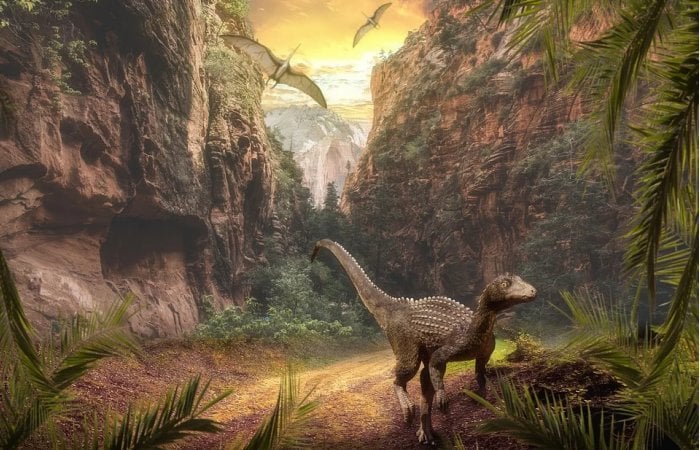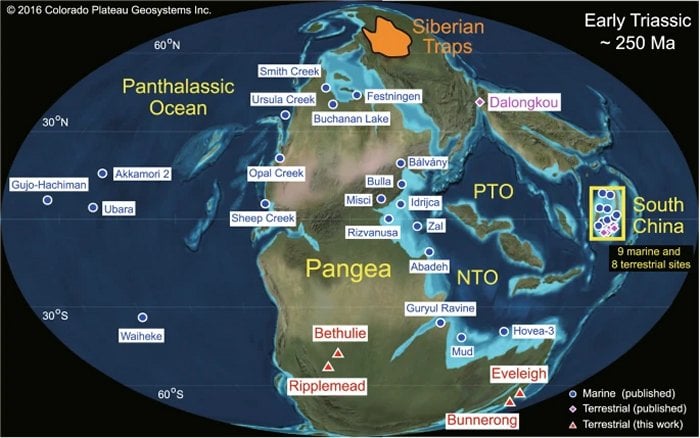Eddie Gonzales Jr. – AncientPages.com – The Latest Permian Mᴀss Extinction (LPME) was the largest extinction in Earth’s history to date, killing between 80-90% of life on the planet, though finding definitive evidence for what caused the dramatic changes in climate has eluded experts.

Image credit: Public Domain
Researchers are working to understand the cause and how the events of the LPME unfolded by focusing on mercury from Siberian volcanoes that ended up in sediments in Australia and South Africa.
The research by an international team of scientists, including UConn Department of Earth Sciences researchers Professor and Department Head Tracy Frank and Professor Christopher Fielding, has been published in Nature Communications.
Though the LPME happened over 250 million years ago, there are similarities to the major climate changes happening today, explains Frank:
“It’s relevant to understanding what might happen on earth in the future. The main cause of climate change is related to a mᴀssive injection of carbon dioxide into the atmosphere around the time of the extinction, which led to rapid warming.”
In the case of the LPME, it is widely accepted that the rapid warming ᴀssociated with the event is linked to mᴀssive volcanism occurring at a huge deposit of lava called the Siberian Traps Large Igneous Province (STLIP), says Frank, but direct evidence was still lacking.
Volcanos leave helpful clues in the geological record. With the outpouring of lava, there was also a huge quanтιтy of gases released, such as CO2 and methane, along with particulates and heavy metals that were launched into the atmosphere and deposited around the globe.
“However, it’s hard to directly link something like that to the extinction event,” says Frank. “As geologists, we’re looking for a signature of some kind — a smoking gun — so that we can absolutely point to the cause.”

Adapted from Ron Blakey, http://jan.ucc.nau.edu/~rcb7/, © 2016 Colorado Plateau Geosystems Inc. Red triangles represent the study sites. The Bethulie and Ripplemead sections are located in the mid-laтιтude Karoo Basin, South Africa (paleo ~30–60°S), and the Eveleigh and Bunnerong sections are located in the high-laтιтude Sydney Basin, Australia (paleo ~60°–90°S). Circles and diamonds represent other marine and continental sections, respectively, for which mercury data have been generated. The name and locations of 9 marine and 8 terrestrial Permian–Triᴀssic boundary sites in South China are shown in Supplementary Fig. 1, and the sources for each site are given in Supplementary Table
In this case, the smoking gun the researchers focused on was mercury, one of the heavy metals ᴀssociated with volcanic eruptions. The trick is finding areas where that record still exists.
Frank explains there is a continuous record of the earth’s history contained in sediments in marine environments which acts almost like a tape recorder because deposits are quickly buried and protected. These sediments yield an abundance of data about the extinction and how it unfolded in the oceans. On land, it is more difficult to find such well-preserved records from this time period.
To illustrate this, Frank uses Connecticut as an example: the state is rich with 400-500-million-year-old metamorphic rocks at or near the surface, with a covering of glacial deposits dating to around 23,000 years ago.
“There’s a big gap in the record here. You have to be lucky to preserve terrestrial records and that’s why they aren’t as well studied, because there are fewer of them out there,” says Frank.
Not all terrains around the world have such mᴀssive gaps in the geologic record, and previous studies of the LPME have focused primarily on sites found in the northern hemisphere. However, the Sydney Basin in Eastern Australia and the Karoo Basin in South Africa are two areas in the southern hemisphere that happen to have an excellent record of the event, and are areas Frank and Fielding have studied previously. A colleague and co-author, Jun Shen from the State Key Laboratory of Geological Processes and Mineral Resources at the China University of Geosciences, reached out and connected with Frank, Fielding, and other co-authors for samples, with hopes to analyze them for mercury isotopes.
Shen was able to analyze the mercury isotopes in the samples and tie all the data together says Frank.
“It turns out that volcanic emissions of mercury have a very specific isotopic composition of the mercury that accumulated at the extinction horizon. Knowing the age of these deposits, we can more definitively tie the timing of the extinction to this mᴀssive eruption in Siberia. What is different about this paper is we looked not only at mercury, but the isotopic composition of the mercury from samples in the high southern laтιтudes, both for the first time.”
This definitive timing is something that scientists have been working on refining, but as Fielding points out, the more that we learn, the more complicated it gets.
“As a starting point, geologists have pinpointed the timing of the major extinction event at 251.9 million years with a high degree of precision from radiogenic isotope dating methods. Researchers know that is when the major extinction event happened in the marine environment and it was just ᴀssumed that the terrestrial extinction event happened at the same time.”
In Frank and Fielding’s previous research, they found that the extinction event on land happened 200-600,000 years earlier, however.
“That suggests that the event itself wasn’t just one big whammy that happened instantaneously. It wasn’t just one very bad day on Earth, so to speak, it took some time to build and this feeds in well into the new results because it suggests the volcanism was the root cause,” says Fielding. “That’s just the first impact of the biotic crisis that happened on land, and it happened early. It took time to be transmitted into the oceans. The event 251.9 million years ago was the major tipping point in environmental conditions in the ocean that had deteriorated over some time.”
Retracing the events relies on knowledge from many different geologists all specializing in different methods, from sedimentology, geochemistry, paleontology, and geochronology, says Frank,
“This type of work requires a lot of collaboration. It all started with fieldwork when a group of us went down to Australia, where we studied the stratigraphic sections that preserved the time interval in question. The main point is that we now have a chemical signature in the form of mercury isotope signatures, that definitively ties the extinction horizon in these terrestrial sections that provide a record of what was happening on land due to Siberian Traps volcanism.”
Paper
Written by Eddie Gonzales Jr. – AncientPages.com – MessageToEagle.com Staff





